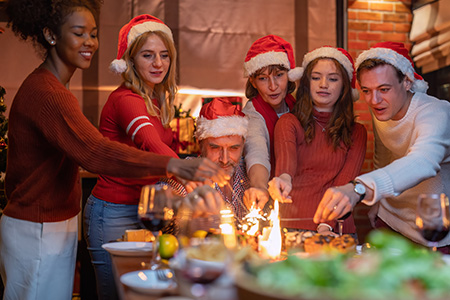Keep The Holidays Merry By Alecia Welch
The holiday season means so much to so many. Families gather to share traditions, meals, and perhaps gift exchanges. As a long-time fire service professional, I saw firsthand how holidays could be ruined forever, in just a blink of an eye. In almost every case where a person was injured or killed, the incident was preventable. Let’s take this time to consider common injuries and some basic preventative measures parents can take to keep their families safe this holiday season.
According to Google AI Overview, the most common injuries and deaths in children during the holiday season are related to toys, plants, and falls.
In 2022, 11 children died and 145,500 were treated in emergency departments for injuries related to toys. The leading cause of death was choking on small parts, balls, or balloons.
To prevent injuries, make sure toys are age-appropriate, that children wear safety gear for rideable toys, and that children are supervised by an adult while playing with a new toy. It is always a good idea for parents to have their basic CPR and first aid certifications or identify someone at your event who has medical training.
Mistletoe and holly are poisonous plants that can cause injuries if left within reach of children and pets. Consider leaving these decorations out altogether or using imitation plants as decoration. Poisoning pets or kids is very preventable.
Falls are a common injury in pediatric trauma centers during the holidays. For example, children may fall while riding new toys like scooters, bicycles, skateboards, or hoverboards. Ensure your child has appropriately sized safety gear including wrist guards, knee pads, and a helmet before you set them out for an adventure on a motorized toy.
In cold climates, weather can be a cause of unanticipated injuries.
Water, ice, and snow can be contributing factors to kids and adults falling and injuring themselves. Check the weather before your party, and if appropriate shovel your walks and apply salt ahead of your guest’s arrival. If you have pets, it’s a good idea to get pet-friendly ice melt. Properly lighted walkways, porches, and doorways also add a measure of safety for your family and guests.
The glass on a fireplace is very hot and can cause third-degree burns to young children. If you use a fireplace, remove stockings or any other hanging décor before you light it. Ensure an active fire is continually supervised so no mishaps can occur. The host of the party should have and know how to use a fire extinguisher. Make sure any flammable items, such as gifts or Christmas trees are located a safe distance from the fire’s flame.
It should go without saying that you should have your fireplace, chimney, and heater cleaned and serviced each year before the cold season. Dust, debris and even sometimes rodents make their way into vents, ducts, and chimneys. Save yourself any problems by scheduling a qualified service provider before your holiday party.
Other holiday injuries and deaths include:
Food poisoning and allergic reactions can occur when eating unfamiliar food at parties and buffets. Try to determine if family members or guests have food allergies before serving the food. Labeling each individual dish is a good preventative measure to inform people of ingredients ahead of ingestion.
Alcohol poisoning is also common during the holidays. Use alcohol in moderation and always designate a driver who will not partake during the party. Stay properly hydrated by drinking a lot of water before and during alcohol consumption.
Serving utensils are a common source for passing germs and disease, so it’s a good idea to encourage guests to wash their hands before food service and have hand sanitizer at the ready for your guests to use as well.
Carbon monoxide (CO) is an odorless, colorless gas that kills without warning. It claims the lives of hundreds of people every year and makes thousands more ill. Fire, EMS and utility company response increase significantly during the holiday season due to improper CO detection. According to the U.S. Centers for Disease Control and Prevention (CDC), many household items including gas- and oil-burning furnaces, portable generators, and charcoal grills produce this poisonous gas.
CO is found in fumes produced any time you burn fuel in cars or trucks, small engines, stoves, lanterns, grills, fireplaces, gas ranges, or furnaces. CO can build up indoors and poison people and animals who breathe it. However, you can reduce your risk of CO poisoning with a few small steps. Install battery-operated or battery back-up CO detectors near every sleeping area in your home.
The CDC recommends that we check CO detector batteries when you change the time on your clocks each spring and fall to be sure they are functioning properly. Consider buying a detector with a digital readout. This type of detector can tell you the highest level of CO concentration in your home, in addition to sounding an alarm. Replace your CO detector following the manufacturer’s instructions or every 5 years. Set a reminder on your smartphone or other device calendar when you purchase and install the detector. It’s also a good idea to write the date you installed the detector right on the unit.
Distracted drivers and small children are at risk in parking lots, driveways, and the like. To avoid accidents, avoid distractions while driving; try leaving your cell phone in the glove compartment or out of the driver’s reach. If you have been drinking, please plan to use a driver or car service. Also, if you have been drinking, it is never a good idea to operate motorized toys or vehicles with children on board. This never ends well.
Please consider these common issues ahead of your holiday gatherings and take basic steps to prevent injuries or death this holiday season. ❦
 About the Author
About the Author
Alicia Welch gained more than 31 years of operational experience in the fire service. 1 year in the City of Lompoc, 3 years in the City of Golden as Fire Chief. She previously served for more than 26 years with the Los Angeles Fire Department (LAFD). She has extensive experience working on special projects and program development. Her final assignment in LAFD was in the Firefighter Recruitment Section within the Training and Support Bureau. There she was tasked with overseeing the implementation of the LAFD Recruitment Plan and focused on improving workforce diversity within the department.
Chief Welch developed her operational and administrative knowledge by working through the ranks as a Firefighter, Battalion Chief Assistant, Fire Inspector, Captain I and II, Battalion Chief, and finally Fire Chief. She worked in active assignments throughout Los Angeles and held administrative assignments in Quality Assurance, Homeland Security, Fire Prevention, and Recruitment.
In September 2005, Chief Welch responded to Hurricanes Katrina and Rita as part of the LAFD’s Critical Incident Stress Management Team. There she was charged with providing peer support to impacted firefighters in the region. She credits this experience to driving her to learn more about responder and family preparedness.
Chief Welch was a member of the LAFD’s Significant Incident Investigation Team, where she developed her technical writing, policy development, and investigation skills. She has had the unfortunate opportunity to conduct post-incident firefighter fatality investigations.
Chief Welch was selected to participate in the development of the LAFD Leadership Academy. As a 2007 graduate from the highly acclaimed Los Angeles Police Department West Point Leadership Academy, she enhanced her leadership, management, and supervisory skill sets.
In the summer of 2009, the Department of Homeland Security/FEMA, in partnership with the Naval Postgraduate School/Center for Homeland Defense and Security announced Chief Welch as one of three distinguished fellows. During the fellowship, Alicia lived in Pentagon City, Virginia, and was assigned to the National Preparedness Directorate at FEMA Headquarters in Washington, DC. She dedicated her year-long assignment to developing a national preparedness model called Ready Responder (see ready.gov/responder).
Alicia earned her Bachelor of Arts Degree in Recreation Management from California State University, Long Beach in 1990. She also earned a Master of Arts Degree in Homeland Security/National Studies from the esteemed Naval Postgraduate School in Monterey, California, in 2006. On July 1, 2019, the Colorado Division of Fire Prevention and Control certified Chief Welch as a Colorado Executive Fire Administrator. Finally, in 2021, Alicia completed the International Association of Fire Chiefs’ Fire Service Executive Development Institute Program.
